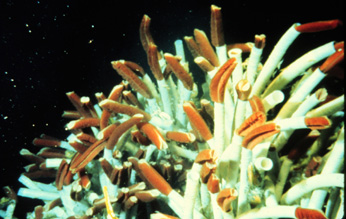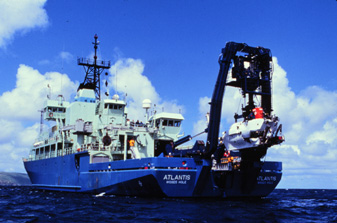Geotimes

Web
Extra Friday, May 24
Hydrothermal
vent anniversary expedition
 Twenty-five
years ago a group of geologists, geophysicists and geochemists ventured 330
kilometers (250 miles) northeast of the Galápagos Islands in search of
what at the time was only a theory: hydrothermal vents. Following the acceptance
of plate tectonics, scientists hypothesized that cold, dense oceanic water seeped
through cracks along underwater volcanic spreading ridges, where hot rocks heated
the water, allowing it to rise to the seafloor as underwater hot springs. Detailed
seafloor maps had given scientists an idea of where to search for evidence of
such springs, but none expected to find a unique community of animals calling
this underwater scene home.
Twenty-five
years ago a group of geologists, geophysicists and geochemists ventured 330
kilometers (250 miles) northeast of the Galápagos Islands in search of
what at the time was only a theory: hydrothermal vents. Following the acceptance
of plate tectonics, scientists hypothesized that cold, dense oceanic water seeped
through cracks along underwater volcanic spreading ridges, where hot rocks heated
the water, allowing it to rise to the seafloor as underwater hot springs. Detailed
seafloor maps had given scientists an idea of where to search for evidence of
such springs, but none expected to find a unique community of animals calling
this underwater scene home.
Tubeworms at the Galápagos Rift.
Photo by John Edmond, MIT/WHOI.
Not a single biologist was on board the expedition when the Woods Hole Oceanographic
Institution's submersible the Alvin brought up giant red tubeworms, clams the
size of dinner plates and ghostly white crabs. The discovery of the hydrothermal
vents and their suite of specialized creatures fundamentally altered our understanding
of the oceans.
 No longer
were the abysmal depths remote places where animals were few and far between,
surviving primarily on what fell from the surface waters above. Here was a community
of animals surviving directly off of the chemicals and mineral-rich waters emerging
from Earth's oceanic crust. Finding a life cycle based on chemosynthesis and
not photsynthesis provided the impetus to examine the potential for such life
forms elsewhere on Earth and in our solar system. Bugs or bacteria living in
acidic environments, on ice or within the extreme temperatures of hydrothermal
vents are today known as extremophiles.
No longer
were the abysmal depths remote places where animals were few and far between,
surviving primarily on what fell from the surface waters above. Here was a community
of animals surviving directly off of the chemicals and mineral-rich waters emerging
from Earth's oceanic crust. Finding a life cycle based on chemosynthesis and
not photsynthesis provided the impetus to examine the potential for such life
forms elsewhere on Earth and in our solar system. Bugs or bacteria living in
acidic environments, on ice or within the extreme temperatures of hydrothermal
vents are today known as extremophiles.
The Research Vessel Atlantis with
the Deep Submergence Vehicle Alvin on the A-frame. Photo by Christopher
Knight, WHOI.
Over the next 11 days, scientists and crew on board the research vessel Atlantis
will again explore the site of the first hydrothermal vent discovery near the
Galápagos Islands. They will look at how the biological community has
changed over time and explore the Galápagos Rift for other undiscovered
hydrothermal vents. Join them on their current expedition by visiting the Dive
and Discover Web page below.
Christina Reed
Links:
Dive and Discover
Ocean Explorer
 Twenty-five
years ago a group of geologists, geophysicists and geochemists ventured 330
kilometers (250 miles) northeast of the Galápagos Islands in search of
what at the time was only a theory: hydrothermal vents. Following the acceptance
of plate tectonics, scientists hypothesized that cold, dense oceanic water seeped
through cracks along underwater volcanic spreading ridges, where hot rocks heated
the water, allowing it to rise to the seafloor as underwater hot springs. Detailed
seafloor maps had given scientists an idea of where to search for evidence of
such springs, but none expected to find a unique community of animals calling
this underwater scene home.
Twenty-five
years ago a group of geologists, geophysicists and geochemists ventured 330
kilometers (250 miles) northeast of the Galápagos Islands in search of
what at the time was only a theory: hydrothermal vents. Following the acceptance
of plate tectonics, scientists hypothesized that cold, dense oceanic water seeped
through cracks along underwater volcanic spreading ridges, where hot rocks heated
the water, allowing it to rise to the seafloor as underwater hot springs. Detailed
seafloor maps had given scientists an idea of where to search for evidence of
such springs, but none expected to find a unique community of animals calling
this underwater scene home. 
 No longer
were the abysmal depths remote places where animals were few and far between,
surviving primarily on what fell from the surface waters above. Here was a community
of animals surviving directly off of the chemicals and mineral-rich waters emerging
from Earth's oceanic crust. Finding a life cycle based on chemosynthesis and
not photsynthesis provided the impetus to examine the potential for such life
forms elsewhere on Earth and in our solar system. Bugs or bacteria living in
acidic environments, on ice or within the extreme temperatures of hydrothermal
vents are today known as extremophiles.
No longer
were the abysmal depths remote places where animals were few and far between,
surviving primarily on what fell from the surface waters above. Here was a community
of animals surviving directly off of the chemicals and mineral-rich waters emerging
from Earth's oceanic crust. Finding a life cycle based on chemosynthesis and
not photsynthesis provided the impetus to examine the potential for such life
forms elsewhere on Earth and in our solar system. Bugs or bacteria living in
acidic environments, on ice or within the extreme temperatures of hydrothermal
vents are today known as extremophiles. 